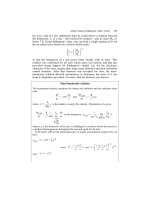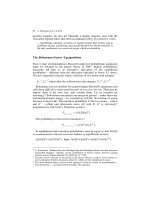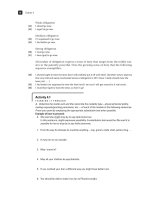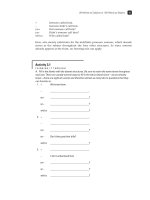Seam Framework Experience the Evolution of Java EE 2nd phần 4 ppsx
Bạn đang xem bản rút gọn của tài liệu. Xem và tải ngay bản đầy đủ của tài liệu tại đây (909.27 KB, 50 trang )
ptg
Step 3: Switch to tab 1 and click on Book Hotel. The application books
the Marriott San Francisco hotel. This makes sense, but only Seam, with
its support for multiple workspaces, can do this easily.
Figure 9.3
@Entity
@Name("user")
@Scope(SESSION)
@Table(name="Customer")
public class User implements Serializable
{
In a Seam application, a workspace maps one-to-one to a conversation, so a Seam
application with multiple concurrent conversations has multiple workspaces. As we
discussed in Section 8.3.4, a user starts a new conversation via an explicit HTTP
GET
request. Thus, when you open a link in a new browser tab or manually load a URL in
the current browser tab, you start a new workspace. Seam then provides you a method
for accessing the old workspace/conversation (see Section 9.2.1).
CHAPTER 9 WORKSPACES AND CONCURRENT CONVERSATIONS
128
From the Library of sam kaplan
Simpo PDF Merge and Split Unregistered Version -
ptg
A group of concurrent conversations with the same user, each uniquely
identifiable by ID
Figure 9.4
The Back Button Works across Conversations and Workspaces
If you interrupt a conversation via an HTTP
GET request (e.g., by manually loading the
main.xhtml page in the middle of a conversation), you can then go back to the interrupted
conversation. When you are backed to a page inside an interrupted conversation, you can
simply click on any button and resume the conversation as if it had never been interrupted.
As we discussed in Section 8.3.4, if the conversation has ended or timed out by the
time you try to return to it, Seam handles this gracefully by redirecting you to a
no-conversation-view-id page (see Section 9.2.2) which is configurable in your
pages.xml. This ensures that, regardless of back-buttoning, the user’s experience remains
consistent with the server-side state.
9.2 Workspace Management
Seam provides a number of built-in components and features that facilitate workspace
and concurrent conversation management. The following sections will explore the fea-
tures provided by Seam to help you manage workspaces in your applications.
Section 9.2.1 will discuss the workspace switcher which provides a simple way to allow
users to swap between workspaces. In Section 9.2.2, we will demonstrate how you can
129
9.2 WORKSPACE MANAGEMENT
From the Library of sam kaplan
Simpo PDF Merge and Split Unregistered Version -
ptg
maintain a workspace even across GET requests. Finally, Section 9.2.3 will discuss how
Seam allows the conversation ID to be manipulated.
9.2.1 Workspace Switcher
Seam maintains a list of concurrent conversations in the current user session in a com-
ponent named
#{conversationList}. You can iterate through the list to see the de-
scriptions of the conversations, their start times, and their last access times. The
#{conversationList} component also provides a means of loading any conversation
in the current workspace (browser window or tab). Figure 9.5 shows an example list of
conversations in the Seam Hotel Booking example. Click on any description link to
load the selected conversation in the current window.
A list of concurrent conversations (workspaces) in the current user
session
Figure 9.5
CHAPTER 9 WORKSPACES AND CONCURRENT CONVERSATIONS
130
From the Library of sam kaplan
Simpo PDF Merge and Split Unregistered Version -
ptg
Below is the JSF page code behind the workspace switcher. It is in the
conversations.xhtml file in the example source code.
<h:dataTable value="#{conversationList}" var="entry">
<h:column>
<h:commandLink action="#{entry.select}"
value="#{entry.description}"/>
<h:outputText value="[current]"
rendered="#{entry.current}"/>
</h:column>
<h:column>
<h:outputText value="#{entry.startDatetime}">
<f:convertDateTime type="time" pattern="hh:mm"/>
</h:outputText>
-
<h:outputText value="#{entry.lastDatetime}">
<f:convertDateTime type="time" pattern="hh:mm"/>
</h:outputText>
</h:column>
</h:dataTable>
The #{entry} object iterates through conversations in the #{conversationList}
component. The #{entry.select} property is a built-in JSF action for loading the
conversation
#{entry} in the current window. Similarly, the #{entry.destroy} JSF
action destroys that conversation. What’s interesting is the
#{entry.description}
property, which contains a string description of the current page in the conversation.
How does Seam figure out the “description” of a page? That requires another XML file.
The
WEB-INF/pages.xml file in the app.war archive file (it is the resources/
WEB-INF/pages.xml
file in the source code bundle) specifies the page descriptions.
This
pages.xml file can also be used to replace the WEB-INF/navigation.xml file for
jBPM-based pageflow configuration (see Section 24.5 for more details). You can learn
more about
pages.xml in Chapter 15. Here is a portion of the content of the pages.xml
file in the Natural Hotel Booking example:
<pages>
</page>
<page view-id="/book.xhtml" timeout="600000" >
<description>
Book hotel: #{hotel.name}
</description>
</page>
<page view-id="/confirm.xhtml" timeout="600000" >
<description>
Confirm: #{booking.description}
</description>
</page>
</pages>
131
9.2 WORKSPACE MANAGEMENT
From the Library of sam kaplan
Simpo PDF Merge and Split Unregistered Version -
ptg
We can reference Seam components by name in the pages.xml file which is very useful
for displaying the description of a conversation.
Why Is the Conversation List Empty or Missing an Entry?
A conversation is only placed into the #{conversationList} component if a page descrip-
tion has been provided. This is often a source of confusion for first-time users, so if you
are unsure as to why your conversation is not appearing in the conversationList, check
your pages.xml configuration.
The conversation switcher shown in Figure 9.5 displays conversations in a table. Of
course, you can customize how the table looks. But what if you want a switcher in a
drop-down menu? The drop-down menu takes less space on a web page than a table,
especially if you have many workspaces. However, the
#{conversationList} compo-
nent is a
DataModel and cannot be used in a JSF menu, so Seam provides a special
conversation list to use in a drop-down menu, which has a structure similar to the
data table.
<h:selectOneMenu value="#{switcher.conversationIdOrOutcome}">
<f:selectItems value="#{switcher.selectItems}"/>
</h:selectOneMenu>
<h:commandButton action="#{switcher.select}"
value="Switch"/>
<h:commandButton action="#{switcher.destroy}"
value="Destroy"/>
9.2.2 Carrying a Conversation across Workspaces
As we discussed earlier, Seam creates a new workspace for each HTTP GET request.
By definition, the new workspace has its own fresh conversation. So, what if we want
to do an HTTP
GET and still preserve the same conversation context? For instance, you
might want a pop-up browser window to share the same workspace/conversation as the
current main window. That’s where the Seam conversation ID comes into play.
If you look at the URLs of the Seam Hotel Booking example application, every page
URL has a
cid URL parameter at the end. This cid stays constant within a conver-
sation. For instance, a URL could look like this:
http://localhost:8080/booking/
hotel.seam?cid=10
.
To
GET a page without disrupting the current conversation, you can append the same
cid name/value pair to your HTTP GET URL.
Appending the
cid value to an URL can be risky. What if you pass in a wrong value
for the
cid parameter? Will the application just throw an error? As a protection, you
CHAPTER 9 WORKSPACES AND CONCURRENT CONVERSATIONS
132
From the Library of sam kaplan
Simpo PDF Merge and Split Unregistered Version -
ptg
can configure the pages.xml file to set a default page to forward to when the URL has
an unavailable
cid value.
<pages no-conversation-view-id="/main.xhtml" >
<page view-id="/confirm.xhtml" conversation-required="true">
</pages>
Requiring a Conversation for the View
Notice the attribute conversation-required specified in the above listing for the
/hotel.xhtml view-id. As we discussed in Chapter 8, this attribute requires that a long-
running conversation be in progress when hotel.xhtml is accessed by the user. This ensures
that if the user has entered a URL directly or bookmarked a page that is not directly
accessible, the user will be redirected to an appropriate location.
Of course, manually entering the cid parameter is not a good idea. So, to go back to
the original question of opening the same workspace in a new window, you need
to dynamically render a link with the right parameter already in place. The following
example shows you how to build such a link. The Seam tags nested in
<h:outputLink>
generate the right parameters in the link.
<h:outputLink value="hotel.seam" target="_blank">
<s:conversationId/>
<s:conversationPropagation propagation="join"/>
<h:outputText value="Open New Tab"/>
</h:outputLink>
Use the <s:link> Tag
You can also use the Seam
<s:link> tag, discussed in Section 8.3.6, to open new browser
windows or tabs within the same conversation. Using the <s:link> tag is generally the
recommended approach to achieve this behavior.
9.2.3 Managing the Conversation ID
As you have probably noted by now, the conversation ID is the mechanism Seam uses
to identify the current long-running conversation. Thus, a unique conversation ID must
be sent with the request, either through
GET or POST, to resume a long-running conver-
sation. In order to make this a little less verbose, Seam enables you to customize the
cid parameter. The name of that parameter is configured in the components.xml file.
Here is our configuration in the Hotel Booking example to use the
cid name for
the parameter:
133
9.2 WORKSPACE MANAGEMENT
From the Library of sam kaplan
Simpo PDF Merge and Split Unregistered Version -
ptg
<components >
<core:manager conversation-timeout="120000"
concurrent-request-timeout="500"
conversation-id-parameter="cid" />
</components>
If you don’t configure this, Seam uses the verbose conversationId name by default.
The
conversation-timeout value shown here is discussed in Sections 8.2.3 and 9.4.
By default, Seam automatically increases the conversation ID value by one for each
new conversation. The default setting is good enough for most applications, but it can
be improved for applications that have many workspaces. The number is not very infor-
mative, and it is hard to remember which workspace is in what state by looking at the
ID numbers. Furthermore, if you have many workspaces opened in tabs, you might
open two different workspaces to perform the same task, and that can get confusing
very quickly.
In the next section, we will discuss natural conversations—the feature Seam provides
to customize the conversation IDs. Natural conversations allow your conversation IDs
to be meaningful and user-friendly.
9.3 Natural Conversations
Managing the conversation ID is not difficult, but it is simply a number fabricated by
Seam. It would be nice if a conversation could be identified by something more mean-
ingful to the developers and users alike. Seam 2 addresses this by supporting natural
conversations.
Natural conversations provide a more natural way of identifying the current conver-
sation among workspaces (or concurrent conversations). This feature allows you to
configure a unique identifier for the entity involved in the conversation that will be used
to identify the conversation itself. Thus, in the Seam Hotel Booking example,
it would be nice to identify conversations based on the hotel being booked (e.g.,
MarriottCourtyardBuckhead). This identifier is meaningful not only to you as a
developer but also to the users of your application.
Using natural conversations, it is quite easy to get user-friendly URLs and simple
redirecting to existing conversations. User-friendly URLs are generally a recommended
practice in today’s web world. They allow users to navigate by simply altering the URL
and to get an idea of what they are currently viewing from the URL. For example, if
my URL reads
http://natural-booking/book/MarriottCourtyardBuckhead, it is
quite obvious that I am trying to book a room at the Marriott Courtyard Buckhead.
CHAPTER 9 WORKSPACES AND CONCURRENT CONVERSATIONS
134
From the Library of sam kaplan
Simpo PDF Merge and Split Unregistered Version -
ptg
Such a URL requires the use of natural conversations in conjunction with URL rewriting
(which will be discussed later in this chapter).
The following sections will discuss how to use natural conversations in practice and
provide an introduction into URL rewriting with Seam.
Natural Conversations versus Explicit Synthetic Conversation IDs
If you have used pre-Seam 2 releases, you may be familiar with explicit synthetic con-
versation IDs. Explicit synthetic conversation IDs are now deprecated; use natural
conversations instead.
9.3.1 Beginning a Natural Conversation via Links
Seam provides excellent support for GET parameters to enable your application to
use RESTful URLs (see Chapter 15). This feature can also be used to achieve a
simple approach to natural conversations. Simply by linking to
/hotels.seam?
hotelId=MarriottCourtyardBuckhead
, we can use the hotelId to initialize our
hotel instance and populate our natural conversation identifier. This approach is used
in the following link from
hotels.xhtml:
<h:outputLink value="#{facesContext.externalContext.requestContextPath}
/hotel.seam?hotelId=#{hot.hotelId}">
View Hotel
</h:outputLink>
The above fragment outputs a standard HTML link to the /hotel.seam view. The query
string specified as
hotelId=#{hot.hotelId} is used to initialize the hotel instance and
subsequently will be used to identify the conversation (which we will discuss
shortly). The expression
#{facesContext.externalContext.requestContextPath}
prepends the current context root to the link, as an <h:outputLink> does not perform
this task for us.
Now that we have a link to our initial conversation page, we need to define our natural
conversation in
pages.xml.
<conversation name="Booking"
parameter-name="hotelId"
parameter-value="#{hotel.hotelId}" />
This definition specifies a natural conversation named Booking. This name is used
to identify the participants in the natural conversation. The
parameter-name and
135
9.3 NATURAL CONVERSATIONS
From the Library of sam kaplan
Simpo PDF Merge and Split Unregistered Version -
ptg
parameter-value define the parameter that will be used to uniquely identify a
conversation instance. You must ensure that the EL expression evaluates to
value when
the conversation is initialized.
Now that we have defined our natural conversation, the pages that participate in it must
be listed.
<page view-id="/hotel.xhtml" conversation="Booking"
login-required="true" timeout="300000">
<param name="hotelId"
value="#{hotelBooking.hotelId}" />
<begin-conversation join="true" />
</page>
<page view-id="/book.xhtml" conversation="Booking"
conversation-required="false" login-required="true"
timeout="600000">
</page>
<page view-id="/confirm.xhtml" conversation="Booking"
conversation-required="true" login-required="true"
timeout="600000">
</page>
You may notice that the portions of our page definition that we elided in Chapter 8 are
now shown. The
conversation attribute is set to the name of the natural conversation
the page participates in. In our example, the
Booking conversation is specified.
Thus, the
hotel.xhtml, book.xhtml, and confirmed.xhtml pages all participate in
the conversation.
Note the use of
<param> in the hotel.xhtml definition. This <param> sets the hotelId
for the hotel to be viewed into the hotelBooking instance. This value of the attribute
can then be used by the
HotelBookingAction to initialize the hotel in the conver-
sation context. This can be easily achieved through a
@Factory method in the
HotelBookingAction.
@Stateful
@Name("hotelBooking")
@Restrict("#{identity.loggedIn}")
public class HotelBookingAction implements HotelSearching
{
//
@Out(required=false)
private Hotel hotel;
//
CHAPTER 9 WORKSPACES AND CONCURRENT CONVERSATIONS
136
From the Library of sam kaplan
Simpo PDF Merge and Split Unregistered Version -
ptg
@Factory(value="hotel")
public void loadHotel()
{
// loads hotel into the conversation based on the RESTful id
hotel = (Hotel) em.createQuery("select h from " +
"Hotel h where hotelId = :identifier")
.setParameter("identifier", hotelId).getSingleResult();
}
//
Notice that the @Factory method is defined for the hotel variable. This means that
when Seam requests the
hotelId from the #{hotel.hotelId} expression specified in
our natural conversation definition, our
hotel instance will be appropriately instantiated.
In addition, the combination of the
<param> and the @Factory method now allows our
page to be bookmarked by a user.
Defining a Unique Key for Your Natural Conversation
You may notice that the unique key used to identify the hotel, MarriottCourtyard-
Buckhead
, is not the primary key. The primary key can be used, but often it is not mean-
ingful to users of your application. Instead, you can define a custom key to identify your
entity, but this key must be unique.
9.3.2 Redirecting to a Natural Conversation
So far we have provided a way to meaningfully identify our conversation through a GET
request—but what if we need to perform a redirect to start a natural conversation? This
can be accomplished by making a few adjustments to our Natural Hotel Booking exam-
ple. First, we can define an action for the
HotelBookingAction that accepts a hotel
instance for booking.
@Stateful
@Name("hotelBooking")
@Restrict("#{identity.loggedIn}")
public class HotelBookingAction implements HotelBooking
{
@PersistenceContext(type=EXTENDED)
private EntityManager em;
@In(required=false) @Out
private Hotel hotel;
//
public String selectHotel(Hotel selectedHotel)
{
hotel = em.merge(selectedHotel);
return "selected";
}
//
137
9.3 NATURAL CONVERSATIONS
From the Library of sam kaplan
Simpo PDF Merge and Split Unregistered Version -
ptg
Note that the @Factory method we used previously has been replaced by an
action that accepts a selected
Hotel instance and merges that instance with the
@PersistenceContext. Now we can define a navigation rule to redirect the user to
hotel.xhtml when a hotel is selected from main.xhtml.
<page view-id="/main.xhtml" login-required="true">
<navigation>
<rule if-outcome="selected">
<redirect view-id="/hotel.xhtml" />
</rule>
</navigation>
</page>
<page view-id="/hotel.xhtml" conversation="Booking"
login-required="true" timeout="300000">
<description>View hotel: #{hotel.name}</description>
<begin-conversation join="true" />
We begin the conversation just as before, but no longer require the specification of a
request parameter. Again, Seam uses the named conversation to determine the natural
conversation ID when beginning the natural conversation. In the
main.xhtml view,
the
<h:outputLink> used previously is changed to a <h:commandLink> to invoke the
newly defined action:
<h:commandLink id="viewHotel"
action="#{hotelSearching.selectHotel(hot)}"
value="View Hotel"/>
<s:conversationName value="Booking" />
</h:commandLink>
The <s:conversationName value="Booking"/> UI component must be provided to
ensure that a natural conversation is resumed if the same hotel is selected. Due to the
timing of processing for conversation propagation specified in navigation rules, the use
of this component is required in this case. By specifying this component, Seam ensures
that if a natural conversation is already in progress for this hotel selection, it will be
resumed.
9.3.3 Resuming a Natural Conversation
So far, the main drawback of this approach is that in both cases, when a hotel is selected
on
main.xhtml, while the same conversation is resumed, selecting that hotel again
would return us to the initial page of the conversation (i.e., the
hotels.xhtml view).
This is because we have essentially hard-coded the navigation into our application by
using an
<h:outputLink> or a navigation rule in pages.xml.
CHAPTER 9 WORKSPACES AND CONCURRENT CONVERSATIONS
138
From the Library of sam kaplan
Simpo PDF Merge and Split Unregistered Version -
ptg
It may be more useful to return the user back to the point in the natural conversation
where he or she left off. As the Natural Hotel Booking example demonstrates, when a
user selects View Hotel for a specific hotel in the
main.xhtml view, this results in a
natural conversation associated with the selected
hotel. If a natural conversation is al-
ready in progress for the selected hotel, the user is returned to the point in the booking
where he or she left off. This can be accomplished through interaction with the core API.
@Stateful
@Name("hotelBooking")
@Restrict("#{identity.loggedIn}")
public class HotelBookingAction implements HotelBooking
{
//
public String selectHotel(Hotel selectedHotel)
{
ConversationEntry entry =
ConversationEntries.instance()
.getConversationEntry("Booking:"
+ selectedHotel.getHotelId());
if(entry != null)
{
entry.select();
return null;
}
hotel = em.merge(selectedHotel);
return "selected";
}
//
Notice the check that is performed prior to initiating the conversation context. The
ConversationEntries component provided by Seam allows us to check for an
existing
ConversationEntry associated with the selected hotel instance. If a
ConversationEntry is found, we simply select that entry, which switches to that con-
versation, just as we saw with the conversation switcher previously. The user is
returned to the point in the conversation where he or she left off.
This approach also avoids the requirement to specify the
s:conversationName compo-
nent in the View Hotel link. As we check for the
ConversationEntry programmatically,
we are assured that the conversation will be resumed appropriately if it is found.
9.3.4 Rewriting to User-Friendly URLs
As already mentioned, natural conversations allow you to create URLs that are navigable
and meaningful. So far, we saw URLs that are somewhat meaningful, but still lack the
desired navigability. By using URL rewriting, we can satisfy both of these requirements.
139
9.3 NATURAL CONVERSATIONS
From the Library of sam kaplan
Simpo PDF Merge and Split Unregistered Version -
ptg
Seam implements a very simple approach to configurating navigable URLs. First, you
need to add the following snippet to your
components.xml file to enable URL rewriting:
<web:rewrite-filter view-mapping="*.seam"/>
The view-mapping parameter must match the servlet mapping defined for the Faces
Servlet in your
web.xml file. If this parameter is not specified, the rewrite filter will
assume the pattern
*.seam.
Once configured, we can specify how URLs should be rewritten per page in the
pages.xml file. The Natural Hotel Booking example demonstrates this:
<page view-id="/hotels.xhtml">
<rewrite pattern="/hotels/{hotelId}" />
</page>
Note that the pattern definition specifies the hotelId query parameter we saw
previously as part of the URL. The above pattern converts the following URL,
/hotels.seam?hotelId=MarriottCourtyardBuckhead, to something much more
navigable:
/hotels/MarriottCourtyardBuckhead.
URL Rewriting Can Be Used for Any GET Request
URL rewriting is not specific to natural conversations and can be quite useful for
RESTful URLs (see Chapter 15). The above configuration could also be applied to any
page in your application that requires a “pretty” URL.
9.4 Workspace Timeout
We discussed the conversation-timeout previously, but now we will revisit the
conversation timeout to see how it relates to user experience. At first glance, most de-
velopers relate
conversation-timeout to session timeout where any conversation will
simply time out after the configured conversation timeout period (see Section 8.2.3).
As you will quickly notice during testing, this is not the case. The conversation timeout
is best explained through interaction with a Seam application. Try the following
configuration in the
components.xml of the Seam Hotel Booking example:
<core:manager conversation-timeout="60000" />
CHAPTER 9 WORKSPACES AND CONCURRENT CONVERSATIONS
140
From the Library of sam kaplan
Simpo PDF Merge and Split Unregistered Version -
ptg
Since the conversation-timeout is measured in milliseconds, the above configuration
sets it to 1 minute. Now, in
web.xml, set the session timeout to 5 minutes:
<session-config>
<session-timeout>5</session-timeout>
</session-config>
In the destroy() method of the HotelBookingAction, add the following line:
//
@Destroy @Remove
public void destroy()
{
log.info("Destroying HotelBookingAction ");
}
//
This will log a message when the conversation ends and the HotelBookingAction is
destroyed. Deploy the
booking example to your local JBoss instance and start up a
conversation. This can be accomplished by logging in, navigating to the hotels listing,
and selecting a hotel for booking. At this point, wait for 1 minute; nothing happens.
Now wait 4 more minutes and the expected message is displayed. The conversation
timed out along with the session.
Why didn’t our conversation time out as configured? This is because the
conversation-timeout only affects background conversations. The foreground con-
versation will only time out when the session times out. As we discussed in Section 8.2.3,
the foreground conversation is simply the conversation that the user last interacted with;
a background conversation is any other conversation in the user’s session. Thus, in our
previous scenario, the foreground conversation timed out with the session as expected.
Let’s try another approach. Perform the same steps as before to go to the booking screen.
Now, open a new window and perform the same steps. We now have a foreground
conversation and a background conversation in progress. Again, wait 1 minute. Nothing
happened. If you wait 4 more minutes, both conversations will time out. So what is
going on here—I thought we had a background conversation? We did, but Seam only
checks the conversation timeout on each request. Thus, if I interact with the foreground
conversation after 1 minute, the background conversation will time out. Try it: Perform
the same steps, wait 1 minute, and then click on the window of the foreground
conversation—and you will see the log message.
This is a very desirable behavior. Essentially, when a user leaves his or her desk for a
period of time and comes back, if the session is still active it would be desirable to
maintain the state the user was previously in—the foreground conversation state of the
141
9.4 WORKSPACE TIMEOUT
From the Library of sam kaplan
Simpo PDF Merge and Split Unregistered Version -
ptg
current workspace. All other background conversations or workspaces are left to time
out after the configured
conversation-timeout period, which reduces the overall
memory consumption. This enables a developer to worry less about memory usage and
cleaning up state and more about developing the business logic. That’s why we’re
here, right?
Why Not Poll for the conversation-timeout?
You may be asking at this point, why doesn’t the conversation-timeout use polling? As
we said, you must interact with the foreground conversation to cause the background
conversations to time out after the conversation-timeout period.
Imagine that the user had many windows open and leaves his or her desk. Whichever
window the user clicks upon return becomes the foreground conversation, timing out any
other background conversations. This gives the user a chance to resume the conversation
he or she chooses, not the one the developer chooses.
You may have noticed in the previous listings that each web page in the conversation
can also have a
timeout value; if a background conversation is idle for too long, the
conversation automatically expires. Note that the
page timeout overrides the global
conversation-timeout for this page. If a page timeout is not specified, the conver-
sation simply times out according to the configured global
conversation-timeout.
<pages>
<page view-id="/hotel.xhtml" timeout="300000" >
</page>
<page view-id="/book.xhtml" timeout="600000" >
</page>
<page view-id="/confirm.xhtml" timeout="600000" >
</page>
</pages>
In the configuration shown in the previous listing, the timeout for hotel.xhtml is
5 minutes, while the timeout for
book.xhtml and confirm.xhtml is 10 minutes. This
seems reasonable, as the user may view multiple hotels prior to making a decision to
book, which would quickly become background conversations. We can time out the
conversations associated with simply viewing the hotel much more quickly than
the booking conversation, as the user is more likely to resume a conversation in the
process of booking.
CHAPTER 9 WORKSPACES AND CONCURRENT CONVERSATIONS
142
From the Library of sam kaplan
Simpo PDF Merge and Split Unregistered Version -
ptg
9.5 Desktop Features in a Stateless Web
Workspaces and conversations are key concepts in Seam, setting Seam apart from pre-
vious generations of stateless web frameworks. It’s easy to develop multiworkspace
web applications using the rich set of Seam annotations and UI tags. However, web
pages in a Seam conversation are typically not bookmarkable because they are tied to-
gether by HTTP
POST requests with a lot of hidden field data. In the next chapter, we
will discuss how to build bookmarkable RESTful URLs into your Seam application.
143
9.5 DESKTOP FEATURES IN A STATELESS WEB
From the Library of sam kaplan
Simpo PDF Merge and Split Unregistered Version -
ptg
This page intentionally left blank
From the Library of sam kaplan
Simpo PDF Merge and Split Unregistered Version -
ptg
In previous chapters we have discussed a number of the features provided by the Seam
conversation model. Long-running conversations provide a great mechanism for
maintaining consistency of state in an application. Unfortunately, simply beginning and
ending a long-running conversation is not always enough. In certain situations, multi-
window operation and using the Back button can still result in inconsistencies between
what the user sees and what the reality of the application’s state is.
Although we’ve managed to segregate state within the HTTP session, there may be
scenarios where the simple conversation model results in the same issues we faced with
the HTTP session. This chapter will discuss the need for nested conversations through
another variation of the Seam Hotel Booking example, the Nested Hotel Booking
example. The
nestedbooking project can be found in the book’s source code bundle.
The Nested Hotel Booking example has the same directory setup as the Hello World and
Natural Hotel Booking examples in the previous chapters (see Appendix B for the
application template).
10.1 Why Are Nested Conversations
Needed?
In the booking example we discussed in Chapters 8 and 9, we might add a new require-
ment. Suppose a user can not only book hotels but, when booking a hotel, certain rooms
may be available depending on the booking dates selected. In addition, the hotels would
like us to provide in-depth descriptions of the rooms to entice users to upgrade their
10
Nested Conversations
145
From the Library of sam kaplan
Simpo PDF Merge and Split Unregistered Version -
ptg
Refactored booking screen that only requires entering check-in and
check-out dates
Figure 10.1
room preferences. This would require inserting additional screens in our booking wizard.
Selecting a hotel for booking is shown in Figure 10.1.
The Select Room button then sends the user to a list of available rooms, as shown in
Figure 10.2.
The user can select any available room which will now appear as part of the booking
package. Suppose the user opens another window with the room selection screen. In
that screen, the user selects the Wonderful Room and proceeds to the confirmation
screen. In the other window, the user decides to see what it would be like to live the
high life, selects the Fantastic Suite for booking, and again proceeds to confirmation.
After reviewing the total cost, the user remembers that his or her credit card is near its
limit! The user then returns to the window showing Wonderful Room and selects
Confirm. Sounds familiar?
Being within a long-running conversation does not protect us from multiwindow oper-
ation within that conversation. Just as with the HTTP session, if a conversation variable
changes, that change affects all windows operating within the same conversation context.
As a result, the user may be charged for a room upgrade that was not intended, leading
to some serious credit card fees due to exceeding the credit limit and a nasty phone call
to customer service.
CHAPTER 10 NESTED CONVERSATIONS
146
From the Library of sam kaplan
Simpo PDF Merge and Split Unregistered Version -
ptg
Additional room selection screen allowing the user to select a room for
booking
Figure 10.2
10.2 Continuing the Conversation
Seam’s conversation model provides a simplified approach to continuations. If you are
familiar with the concept of a continuation server, you are aware of the capabilities they
provide, including seamless Back button operation and automatic state management.
A user session has many continuations, which are simply snapshots of state during
execution and can be reverted to at any time. If you are not familiar with this concept,
do not worry—Seam makes it easy.
The simple conversation model we discussed before is only part of the equation. In
Seam, you also have the ability to nest conversations. A conversation is simply a state
container, as we saw in Chapter 8. Each booking occurs in its own conversation. As we
saw before, based on the conversation ID, or
cid for short, the appropriate hotel and
booking will be injected each time the
HotelBookingAction is accessed.
147
10.2 CONTINUING THE CONVERSATION
From the Library of sam kaplan
Simpo PDF Merge and Split Unregistered Version -
ptg
10.2.1 Understanding the Nested Conversation Context
Nesting a conversation provides a state container that is stacked on top of the state
container of the original, or parent, conversation. You can view this as a concept similar
to the relationship between a conversation and the HTTP session. Any objects changed
in the nested conversation’s state container will not affect the objects accessible in the
parent conversation’s state container.
This allows each nested conversation to maintain its own unique state, as shown in
Figure 10.3. As noted in previous chapters, when Seam performs a lookup of the
roomSelection object, it looks at the current conversation determined by the cid. Thus,
the appropriate
roomSelection is injected based on the user’s conversation context. In
addition, the appropriate hotel and booking instances will also be injected, based on the
outer conversation. Let us see how this impacts our interaction scenario.
A conversation with two nested conversations. Each nested conversation
has its own unique state as well as access to the parent conversation’s
state.
Figure 10.3
CHAPTER 10 NESTED CONVERSATIONS
148
From the Library of sam kaplan
Simpo PDF Merge and Split Unregistered Version -
ptg
In the previous example, when the user reaches the Book Hotel screen, the application
is operating within a long-running conversation. A click on the Select Room button
shows the list of available rooms. Once a room is selected, a conversation is nested.
Thus, regardless of whether the user opens multiple windows, the state is unique for
each room selection. The appropriate nested conversation is restored unaffected by a
roomSelection made in any other nested conversation.
Note that if Seam does not find the requested object in the nested conversation, it will
seek out the object in the parent conversation, as shown in Figure 10.3 with the
hotel
and booking instances. Since Seam cannot find these objects in the nested conversation
state container, it will traverse the
conversationStack, which will be discussed further
in Section 10.3, to retrieve the object instances. Thus, both conversations,
cid=2 and
cid=3, share the hotel and booking instances as they are nested within the same parent
conversation. If these objects are not found in the
conversationStack, Seam will
traverse the remaining contextual scopes as usual.
The “Read-Only” Parent Conversation Context
The parent conversation’s context is read-only within a nested conversation, but because
objects are obtained by reference, changes to the objects themselves will be reflected in
the outer context. This means that if in the previous example we outject an object in the
nested conversation named hotel, this object would only be accessible in the nested
conversation. The hotel reference in the parent conversation remains the same.
As Seam looks in the current conversation context for a value before looking in the parent,
the new reference will always be applicable in the context of the nested conversation or
any of its children. However, because context variables are obtained by reference, changes
to the state of the object itself will impact the parent conversation. Thus, changing
the internal state of parent conversation variables within a nested conversation is not
recommended as the parent and all nested conversations will be impacted.
Now that we know how the nested conversation context works, let’s look at how nested
conversations can be managed in practice.
10.2.2 Nesting Conversations
We have seen what nested conversations provide and discussed the semantics of a
nested conversation context, but how difficult can it be to achieve this magic? The
following listing contains the
RoomPreferenceAction which allows the user to select
a
Room in the rooms.xhtml view:
149
10.2 CONTINUING THE CONVERSATION
From the Library of sam kaplan
Simpo PDF Merge and Split Unregistered Version -
ptg
@Stateful
@Name("roomPreference")
@Restrict("#{identity.loggedIn}")
public class RoomPreferenceAction implements RoomPreference
{
@Logger private Log log;
@In private Hotel hotel;
@In private Booking booking;
@DataModel(value="availableRooms")
private List<Room> availableRooms;
@DataModelSelection(value="availableRooms")
private Room roomSelection;
@In(required=false, value="roomSelection")
@Out(required=false, value="roomSelection")
private Room room;
@Factory("availableRooms")
public void loadAvailableRooms()
{
this.availableRooms =
this.hotel.getAvailableRooms(
booking.getCheckinDate(), booking.getCheckoutDate());
log.info("Retrieved #0 available rooms", availableRooms.size());
}
public BigDecimal getExpectedPrice()
{
log.info("Retrieving price for room #0", room.getName());
return booking.getTotal(room);
}
@Begin(nested=true)
public String selectPreference()
{
log.info("Room selected");
this.room = this.roomSelection;
return "payment";
}
public String requestConfirmation()
{
// All validations are handled through the s:validateAll,
// so checks are already performed.
log.info("Request confirmation from user");
return "confirm";
}
CHAPTER 10 NESTED CONVERSATIONS
150
From the Library of sam kaplan
Simpo PDF Merge and Split Unregistered Version -
ptg
@End(beforeRedirect=true)
public String cancel()
{
log.info("ending conversation");
return "cancel";
}
@Destroy @Remove
public void destroy() {}
}
As you can see, when the user selects a room, we nest a conversation. By using Seam’s
@DataModel and @DataModelSelection, which are discussed in Chapter 13, we are
able to simply outject the
room back to the nested conversation context once it is selected.
The user is then sent to the payment screen through a navigation rule defined in
pages.xml. When rendering the payment screen, the new roomSelection instance is
retrieved from the nested conversation context. Similarly, when the confirmation screen
is displayed, the
roomSelection will be retrieved from the context, as shown in
Figure 10.4.
The roomSelection being displayed on the payment.xhtml view-idFigure 10.4
151
10.2 CONTINUING THE CONVERSATION
From the Library of sam kaplan
Simpo PDF Merge and Split Unregistered Version -
ptg
Bijection with Nested Conversations
Note that we only inject the hotel and booking values from the conversation context.
Outjection is not necessary here, as these attributes are already present in the parent con-
versation context. This makes them available for injection in the nested conversation.
If the user confirms booking, the correct roomSelection will always be found for the
current conversation regardless of multiwindow operation.
You may then ask, what happens once the user has confirmed the booking for the
hotel
and roomSelection? What if the user then goes back to the Wonderful Room and
confirms? We end the entire conversation stack when the user confirms a booking. As
before, Seam recognizes that the conversation has ended and redirects the user to the
no-conversation-view-id, as shown in the following listing. The conversation stack
is described in the next section.
<pages no-conversation-view-id="/main.xhtml"
login-view-id="/home.xhtml" />
10.3 The Conversation Stack
When a nested conversation is started, the semantics are essentially the same as beginning
a normal long-running conversation except that a nested conversation will be pushed
onto the conversation stack. As mentioned previously, nested conversations have access
to their outer conversation’s state, but setting any variables in a nested conversation’s
state container will not impact the parent conversation. In addition, other nested
conversations can exist concurrently, stacked on the same outer conversation,
allowing independent state for each.
The conversation stack is essentially what you would expect—a stack of conversations.
The top of the stack is the current conversation. If the conversation is nested, its parent
conversation would be the next element in the stack, and so on until the root conversation
is reached. The root conversation is the conversation where the nesting began; it has
no parent conversation. Let’s look at the details of managing the conversation stack.
10.3.1 Managing the Conversation Stack
Nesting a conversation can be accomplished in the same way as beginning a general
long-running conversation which we discussed in Chapter 8. As you saw in our previous
listing, nesting simply requires the addition of the
nested attribute.
CHAPTER 10 NESTED CONVERSATIONS
152
From the Library of sam kaplan
Simpo PDF Merge and Split Unregistered Version -









